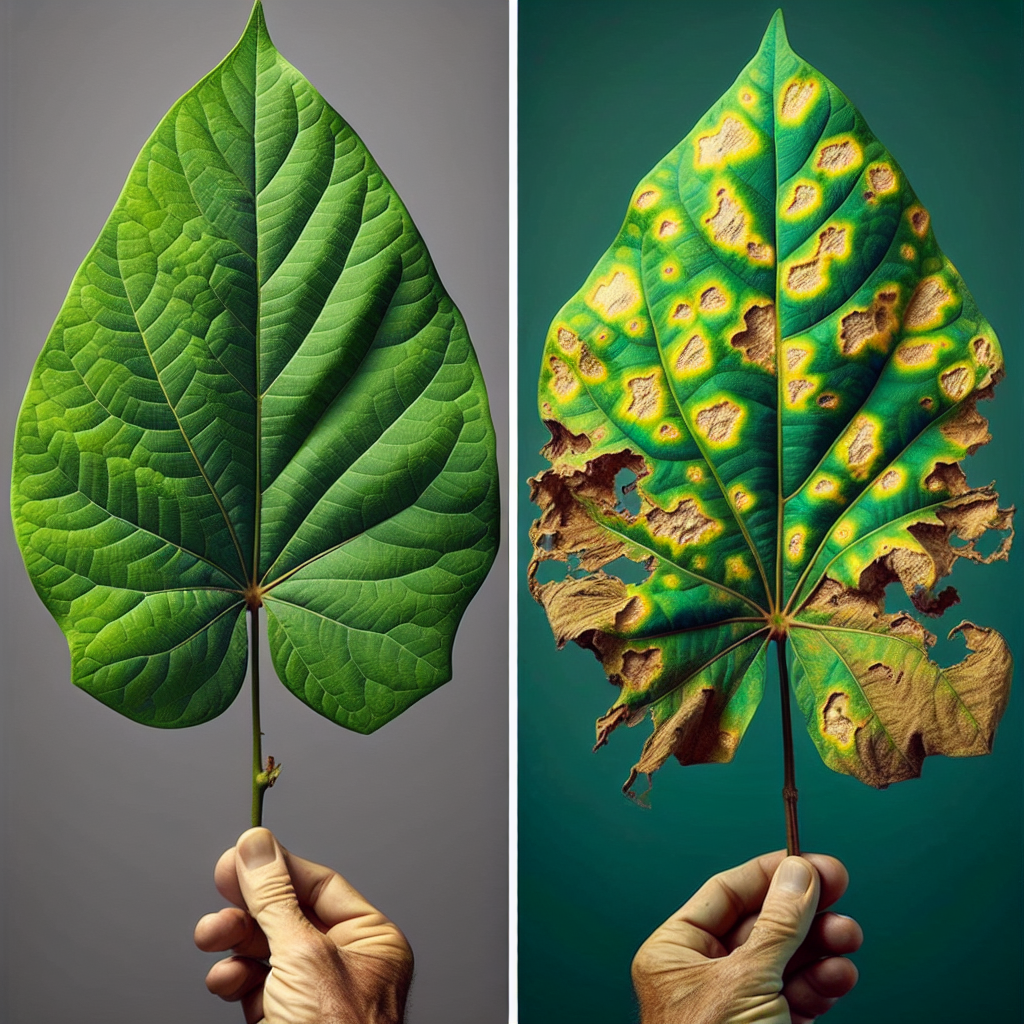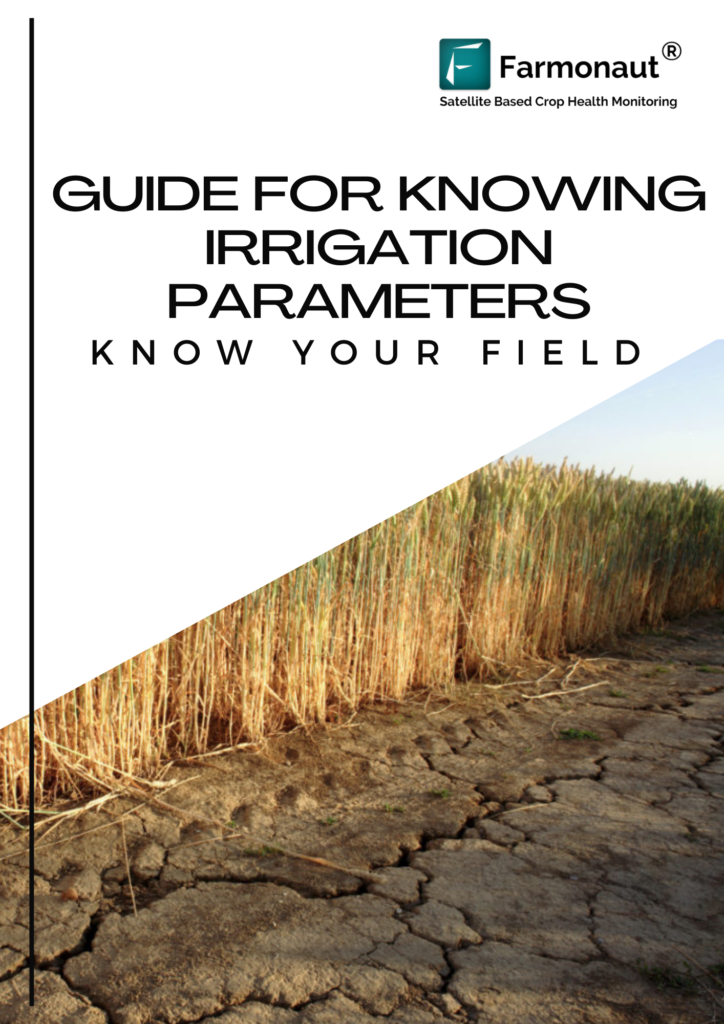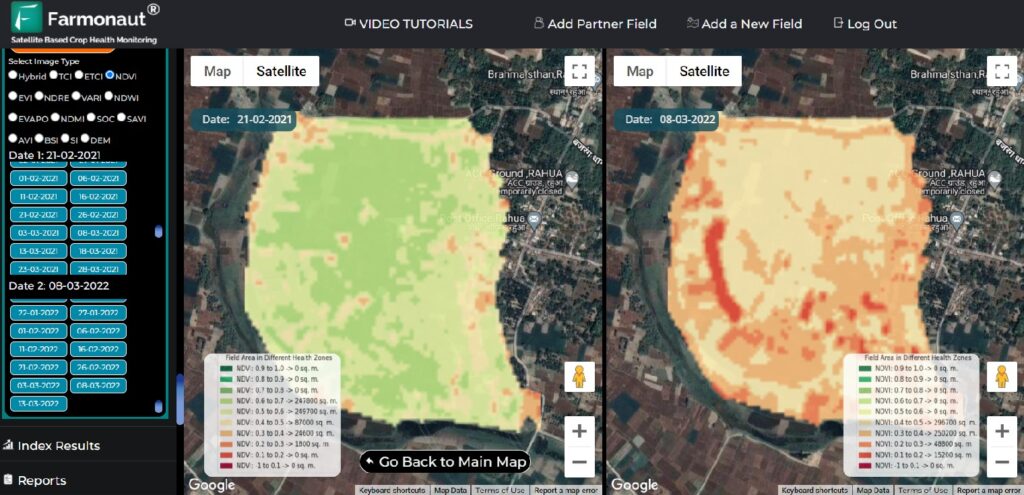Understanding Angular Leaf Spot of Cotton: Causes, Symptoms, and Management

As agricultural technology experts at Farmonaut, we understand the importance of maintaining healthy cotton crops for optimal yields. One of the most significant challenges cotton farmers face is the angular leaf spot of cotton, a bacterial disease that can severely impact crop productivity. In this comprehensive guide, we’ll delve into the causes, symptoms, and management strategies for this destructive disease, helping you protect your cotton fields and maximize your harvest.
What is Angular Leaf Spot of Cotton?
Angular leaf spot is a bacterial disease that affects cotton plants, primarily targeting the leaves, but can also impact bolls and stems. This disease is caused by the bacterium Xanthomonas citri pv. malvacearum, formerly known as Xanthomonas campestris pv. malvacearum. The disease gets its name from the characteristic angular-shaped lesions that develop on the cotton leaf, which are confined by the leaf veins.
Causes of Angular Leaf Spot in Cotton
Angular leaf spot of cotton is caused by the bacterium Xanthomonas citri pv. malvacearum. This pathogen thrives in warm, humid conditions and can spread rapidly through a cotton field under favorable circumstances. The primary factors contributing to the development and spread of angular leaf spot include:
- High humidity and frequent rainfall
- Temperatures between 25°C and 30°C (77°F to 86°F)
- Overcrowded planting
- Poor air circulation within the crop canopy
- Contaminated seeds
- Infected plant debris from previous seasons
- Mechanical transmission through farm equipment
Symptoms and Identification
Recognizing the symptoms of angular leaf spot is crucial for early detection and management. Here’s what to look for on your cotton leaf:
- Initial symptoms: Small, water-soaked lesions on the underside of leaves
- Lesion development: As the disease progresses, lesions become angular and confined by leaf veins
- Color changes: Lesions turn brown to black and may have a yellow halo
- Leaf damage: Severely affected leaves may become ragged and eventually fall off
- Stem and boll symptoms: Dark, sunken lesions on stems and bolls in advanced cases

Angular Leaf Spot of Cotton Diagram
To better understand the progression and appearance of angular leaf spot, let’s examine a typical angular leaf spot of cotton diagram:
[Note: As an AI language model, I cannot generate or display images. However, a typical diagram would show:
- A healthy cotton leaf for comparison
- Early-stage water-soaked lesions
- Developed angular lesions confined by leaf veins
- Advanced-stage lesions with brown to black coloration and yellow halos
- Severely damaged leaves with ragged edges
This visual representation helps in identifying the disease at various stages of development.]
Cotton Leaf Diagram
Understanding the structure of a healthy cotton leaf is essential for identifying disease symptoms. A typical cotton leaf diagram would include:
- Leaf blade: The broad, flat part of the leaf
- Midrib: The central vein running down the middle of the leaf
- Lateral veins: Smaller veins branching out from the midrib
- Petiole: The stalk that attaches the leaf to the stem
- Leaf margin: The edge of the leaf, which can be smooth or serrated
- Stomata: Tiny pores on the leaf surface for gas exchange
Familiarizing yourself with the normal structure of a cotton leaf will help you quickly identify any abnormalities caused by diseases like angular leaf spot.
Management and Prevention Strategies
At Farmonaut, we believe in a proactive approach to disease management. Here are some strategies to prevent and control angular leaf spot in cotton:
- Use resistant varieties: Plant cotton varieties that have shown resistance to angular leaf spot
- Practice crop rotation: Rotate cotton with non-host crops to break the disease cycle
- Implement proper sanitation: Remove and destroy infected plant debris after harvest
- Optimize planting practices: Ensure proper spacing between plants for good air circulation
- Use certified seeds: Plant disease-free, certified seeds to reduce the risk of infection
- Apply copper-based fungicides: Use as a preventive measure or at the first sign of disease
- Monitor and scout regularly: Conduct frequent field inspections to catch early signs of infection
- Manage irrigation: Avoid overhead irrigation and water early in the day to reduce leaf wetness duration
- Control weeds: Remove weeds that may serve as alternative hosts for the pathogen
- Disinfect equipment: Clean and disinfect farm equipment to prevent mechanical transmission
The Role of Technology in Disease Management
At Farmonaut, we leverage cutting-edge technology to help farmers combat diseases like angular leaf spot more effectively. Our satellite-based crop health monitoring system provides early detection of potential issues, allowing for timely intervention. Here’s how our technology compares to traditional monitoring methods:
| Feature | Farmonaut Satellite System | Drone-based Monitoring | IoT-based Monitoring |
|---|---|---|---|
| Coverage Area | Large-scale (entire fields) | Limited by flight time and regulations | Limited by sensor placement |
| Frequency of Data | Regular updates (every 3-5 days) | As needed, weather-dependent | Continuous, real-time |
| Cost-effectiveness | High (no equipment needed) | Moderate (equipment and operator costs) | Low (high initial setup costs) |
| Data Analysis | AI-powered, comprehensive | Requires specialized software and expertise | Limited to sensor capabilities |
| Ease of Use | User-friendly mobile app | Requires trained operators | Requires technical setup and maintenance |
To learn more about how Farmonaut can help you manage cotton diseases like angular leaf spot, visit our app page or explore our API documentation.
The Future of Cotton Disease Management
As we continue to innovate in the field of agricultural technology, the future of cotton disease management looks promising. Advanced satellite imagery, machine learning algorithms, and AI-powered advisory systems are revolutionizing how we detect, predict, and manage diseases like angular leaf spot.
At Farmonaut, we’re committed to developing solutions that make precision agriculture accessible to farmers worldwide. Our Jeevn AI Advisory System, for instance, provides personalized recommendations based on real-time crop health data, helping farmers make informed decisions about disease management.
To stay ahead of the curve and protect your cotton crops effectively, consider integrating our advanced technologies into your farming practices. Download our mobile app for Android or iOS to get started.
Conclusion
Understanding and managing angular leaf spot of cotton is crucial for maintaining healthy crops and ensuring optimal yields. By combining traditional agricultural practices with modern technology, farmers can effectively prevent and control this destructive disease. Remember, early detection and prompt action are key to mitigating the impact of angular leaf spot on your cotton fields.
At Farmonaut, we’re dedicated to empowering farmers with the tools and knowledge they need to succeed. For more information on our satellite-based crop monitoring services and how they can help you manage cotton diseases, visit our developer documentation.
FAQs
- Q: Can angular leaf spot of cotton spread to other crops?
A: Angular leaf spot is specific to cotton and closely related Malvaceae family plants. It doesn’t typically spread to unrelated crops. - Q: How quickly can angular leaf spot spread in a cotton field?
A: Under favorable conditions (warm, humid weather), angular leaf spot can spread rapidly, potentially affecting an entire field within a few weeks. - Q: Are there any natural predators that can control the bacteria causing angular leaf spot?
A: While some beneficial microorganisms may compete with the pathogen, there are no known natural predators that effectively control angular leaf spot in cotton. - Q: How does Farmonaut’s satellite monitoring help in detecting angular leaf spot?
A: Our satellite monitoring system detects changes in vegetation health, allowing for early identification of potential disease outbreaks, including angular leaf spot. - Q: Can angular leaf spot be completely eliminated from a cotton field?
A: Complete elimination is challenging, but with proper management practices and the use of resistant varieties, the impact of angular leaf spot can be significantly reduced.
Stay informed and protect your cotton crops with Farmonaut’s advanced agricultural solutions. Subscribe to our services today to access real-time crop health monitoring and personalized advisory:












